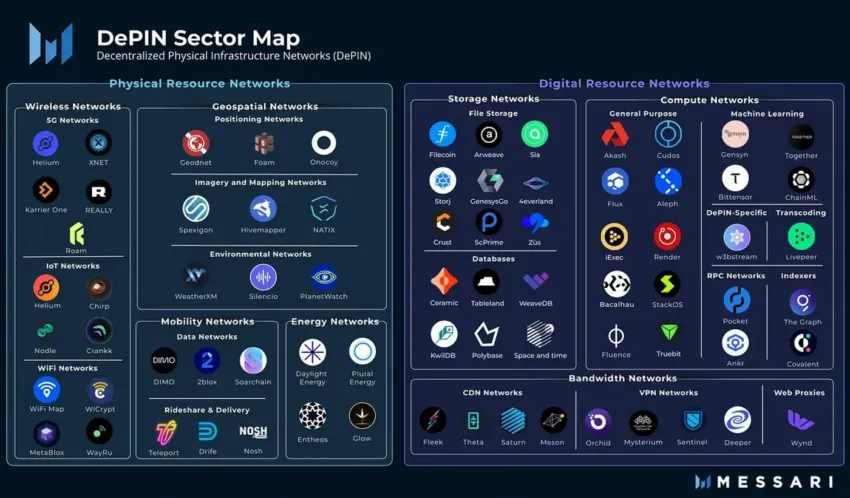
Integrating blockchain technology with tangible, real-world applications is becoming increasingly significant. Indeed, Decentralized Physical Infrastructure Networks (DePIN) is a sector experiencing exponential growth. Around 650 new projects were launched, catapulting DePIN’s market capitalization to an impressive $20 billion and generating an estimated $15 million in annualized on-chain revenue.
The growing interest in DePIN reflects the potential to revolutionize traditional systems by democratizing access to essential services and fostering community-driven solutions.
The Promise of DePIN to Disrupt Monopolies
DePIN stands at the forefront of marrying cryptocurrency’s decentralized ethos with the physical world’s infrastructural needs. From Wi-Fi and transportation to data storage and energy, DePIN sets the stage for blockchain’s transparency, efficiency, and security to extend to the real world. This shift aims to enhance blockchain’s utility and offer users tangible benefits and rewards.
It is worth noting that this sector is currently controlled by three of the world’s largest and most reputable technology firms — Microsoft, Google, and Amazon. Consequently, forging partnerships, developing business, and generating organic demand might prove more challenging in this crypto area than others. Therefore, success largely depends on the ongoing trend of increased censorship by Big Tech.
Still, crypto infrastructure is anticipated to grow exponentially in regions where governments intensify restrictions on dissent and impose stricter controls on freedom of speech. This scenario presents significant opportunities for serving gray market customers.
“DePIN will be one of the most important areas of crypto investment for the next decade. Storage solutions, decentralized wireless networks, and other hardware networks are critical to the industry’s long-term viability. They could also disrupt an absolutely ginormous set of monopolies. Legacy cloud infrastructure is a $5 trillion global market cap sector,” analysts at Messari wrote.
Indeed, the allure of DePIN lies in its promise to decentralize wealth and control associated with infrastructure development. It enhances the capabilities of the Internet of Things (IoT) by integrating blockchain and community-driven incentives. Essentially, DePIN pools the necessary computational and storage capacities from various sources, making them readily available for developers and their applications.
Shann Holmberg, Chief Operating Officer at Lunar Strategy, told BeInCrypto that such a framework promises to lower operational costs, scale efficiently, and offer a robust alternative to traditional infrastructural models.
“By decentralizing the resources, it allows for the widespread adoption of innovative technologies, even in remote or underdeveloped areas. This global reach empowers users from all corners of the world to engage with and benefit from decentralized technologies, fostering a more inclusive digital environment,” Holmberg said.
This approach is gaining traction among crypto investors who see it as a scalable solution to global infrastructure challenges. DePIN aims to transform public infrastructure into a more inclusive, efficient, and participatory system by leveraging blockchain.
The impact of DePIN on Web3 is profound. It offers a decentralized model that alleviates bottlenecks and fosters a more reliable platform for decentralized applications (dApps). By improving resource availability and global accessibility, DePIN catalyzes the widespread adoption of innovative technologies, especially in underserved regions.
“DePIN transforms traditional infrastructural systems by decentralizing control, shifting it from large corporations to a community of individual contributors. Similar to miners in a Proof-of-Work network, each participant contributes resources and has a say in the system proportional to their investment,” Holmberg added.
Top DePIN Projects to Keep an Eye On
Developing effective incentive models, navigating the extended development, and competing with established Web2 giants can be challenging. Yet, the potential benefits of community control, fair pricing, and incentivization present a compelling case for DePIN’s transformative power.
“Things like file storage, wireless access, and cloud computing require lots of capital expenditure and operational headaches, and it’s a non-trivial challenge to scale a hardware network to viability. Tokens have proven effective at catalyzing the development of these networks as they coordinate decentralized hardware investment at scale,” analysts at Messari emphasized.
Indeed, DePIN projects like Rowan Energy are pioneering sustainable practices. It leverages blockchain for clean energy production and consumption in the energy sector. This innovative approach supports the global pursuit of net-zero emissions and incentivizes renewable energy adoption through mechanisms like NFT Carbon Offset Certificates.
The wireless sector, too, is witnessing a revolution with projects like Helium Network. It aims to disrupt traditional connectivity models by rewarding providers with cryptocurrency. This model exemplifies how DePIN can offer equitable solutions in connectivity, marking a significant shift from centralized providers.
“Helium Network is challenging the dominance of large network providers. With a clever multi-token system, each token plays a crucial role in managing network resources and compensating providers. Users burn the HNT token to access connectivity services, and the MOBILE token is the lifeblood of Helium’s 5G project,” Holmberg explained.

Meanwhile, decentralized storage networks like Filecoin redefines data storage and cloud computing. By ensuring secure, efficient, and affordable storage solutions, these projects highlight DePIN’s potential to challenge and possibly outperform traditional cloud services.
“Without data, an AI can’t learn. If the data is compromised due to a single point of failure, or the central data storage entity changes access rights or its prices, an AI that is dependent on that storage entity will cease to be. It is an existential risk, which is why I argue that AIs must use a decentralized storage solution,” BitMEX Co-Founder Arthur Hayes said.
Read more: Filecoin (FIL) Price Prediction 2024 / 2025 / 2030
Despite challenges, DePIN projects signal a robust move towards more democratic, efficient, and sustainable infrastructural solutions. This transformative journey is about technological advancement and reimagining the foundational systems that support the digital and physical worlds.
Disclaimer
All the information contained on our website is published in good faith and for general information purposes only. Any action the reader takes upon the information found on our website is strictly at their own risk.
Be the first to comment